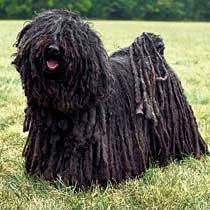|
The Canine Chronicles
Directory
Puli

The coat on the Puli is very unique. They have a weather-resistant, double coat.
The outercoat fuses with the undercoat causing long cords to develop and hang
from their body. The coat is black, any shade of gray, apricot and the rarer
white is permissible. Puppies are born with a downy coat. Their cords begin to
form around 3 to 4 months and take about 2 years to form completely. The head
and muzzle are large and short. The triangular ears are elongated and lie close
to the body. The eyes are dark brown and the nose is black. The mouth is strong
with teeth that meet in a scissor-like bite. The body is broad and muscular
with a deep chest and a level topline. The shoulders should be laid back and
the legs straight, well-boned and muscular. The rear dewclaws must be removed.
The large feet have well-arched toes and black, firm pads. The tail should
curve tightly over the back.
|
|
Temperament
|
Pulis are lively and cheerful. They are very loyal to their families and
property. Though they may be wary towards strangers, they are never aggressive,
giving a vocal warning if they feel threatened. This breed is not recommended
for small children, although if they are raised with the children, they will do
just fine. They are very intelligent and easy to train but can tend to have a
mind of their own.
|
|
Height, Weight
|
Male Height: 16-17" ; Weight: 25-35 lbs.
Female Height: 14-16" ; Weight: 20-30 lbs.
|
|
Health Problems
|
The Puli is prone to hip dysplasia and glaucoma.
|
|
Living Conditions
|
This breed will adapt to its surroundings be it an apartment or a farm. They do
well in any climate. They are active indoors, but do better with a yard.
|
|
Exercise
|
This breed loves to exercise and will meet its own needs for exercise if kept
outdoors. Some are very fond of water but some in the breed cannot swim. Always
supervise around water.
|
|
Life Expectancy
|
12 or more years
|
|
Grooming
|
The long and shaggy coat of this breed should never be trimmed. Regular coat
separation and bathing is necessary. It takes a long time for this breed's coat
to dry; sometimes up to 2 days! Check eyes and ears regularly and clip nails
often. They shed very little if at all.
|
|
Origin
|
The origins of this breed are unknown; however, it has been documented that the
Magyars, a tribe of nomadic Huns, brought Puli's to Hungary around a 1000 years
ago during the 9th century AD. The breed was thought to have originated from
Tibetan Terrier although this has never been proven. They were initially bred
for their ability to work. They were used to herd and protect flocks. Lighter
colored Puli's were used to guard and the darker colored Puli's were used to
herd and drove. Hungary was involved in several wars and after World War II, the
Puli breed was close to extinction. However, due to the assistance of Emil
Raitsits, a controlled breeding program was established, ensuring the survival of
this breed. In 1936, the AKC was the first to recognize this breed. They have
since been successful as police dogs and have placed well in shows and
obedience competitions.
|
|
Group
|
Herding
|